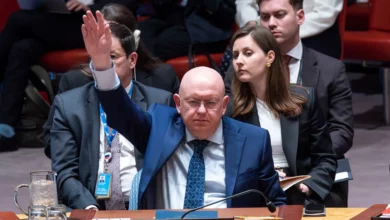
The report by the UK-based International Institute for Strategic Studies (IISS) estimated Russia has lost more tanks on the battlefields in Ukraine than it had when it launched its full-scale invasion nearly two years ago, but these losses were not likely to “cause an end to the fighting anytime soon.”
“Despite losing hundreds of armored vehicles and artillery pieces per month on average, Russia has been able to keep its active inventory numbers stable” by reactivating old systems, boosting its industrial capacity and buying from abroad, the think tank said.
The IISS estimated that Russia can “sustain its assault on Ukraine for another two or three years, and maybe even longer.”
The report comes as Russia’s invasion of Ukraine nears its second anniversary, with Moscow’s forces conducting a flurry of offensives along the nearly 1,000-kilometer frontlines in an attempt to break what Ukraine’s former top general described last year as a “stalemate.”
Meanwhile, Ukraine is shifting to a more defensive footing after its much-vaunted counteroffensive last summer failed to reap the desired gains, and as it struggles with its own manpower constraints and the supply of ammunition from the West begins to run dry.
The United States Senate on Tuesday passed a $95.3 billion foreign aid bill, including $60 billion in support for Ukraine, setting up a showdown with the House as Speaker Mike Johnson said he did not plan to bring the bill to the floor.
In its separate annual Military Balance report, the IISS said global defense spending increased by 9% to a record $2.2 trillion in 2023, the IISS said, as the world adjusts to what it called an “era of instability.” It said Russia’s invasion had spurred European countries to boost defense spending and strengthened NATO, but said much of the additional funding was “scrambling to rectify shortcomings from years of underinvestment.”
It noted that the European Union is on track to miss “by a wide margin” its target of delivering Ukraine 1 million 155-millimeter shells by March.
“Western governments find themselves once again in a position where they must decide whether to furnish Kyiv with enough weapons to deliver a decisive blow, rather than just enough arms not to lose,” Bastian Giegerich, director general of the IISS, said Tuesday.
‘Intense’ losses
While Russia has suffered “intense” armored vehicle losses since February 2022, the IISS said “there are few signs they will cause an end to the fighting anytime soon.”
The report tracked the active fleets of both Russia and Ukraine’s main battle tanks (MBTs), armored personnel carriers (APCs), infantry fighting vehicles (IFVs) and other equipment. It cross-referenced indicated losses from battlefield images with other information sources, including data leaked from the Pentagon and open-source trackers, but said estimating the losses is an “imprecise science.”
It said Ukraine’s number of active MBTs “remains near pre-war levels,” while its number of APCs and IFVs “increased thanks to Western support.” Despite this, it warned Ukraine’s attempts to field these additional vehicles “outpaced equipment supply,” meaning some units did not have enough equipment to be close to full strength.
Russia, meanwhile, has lost more than 3,000 armored fighting vehicles in the past year alone, the report said, but this was offset by its reactivating around 1,200 MBTs and nearly 2,500 IFVs and APCs from storage. While this has meant trading “quality for quantity,” Russia has also been able to manufacture new vehicles. The authors concluded Russia could sustain its current rate of attrition for up to three years and maybe longer.
The report also detailed how, despite international sanctions, Russia’s economy had proved resilient and it had ramped up defense spending for 2024.
“Russia has raised its official defense budget for 2024 more than 60% year-on-year. Total military spending now represents one third of its national budget and will reach about 7.5% of GDP, signaling the focus on its war effort,” Giegerich said.

The Royal United Services Institute (RUSI), another think tank, published its own report this week on Russia’s shifting military objectives and capacity.
“Russia still maintains the strategic objective of bringing about the subjugation of Ukraine. It now believes that it is winning,” it said.
The report said Russia will seek to achieve its objective in three stages.
First, it will aim to continue pressure along the Ukrainian frontlines, draining its munitions and manpower.
“Parallel to this effort, the Russian Special Services are tasked with breaking the resolve of Ukraine’s international partners to continue to provide military aid,” it said.
Then, once Ukrainian munition stocks are depleted, Russia will mount fresh offensive operations to make significant advantages on the battlefield, in an attempt to gain leverage over Kyiv “to force capitulation on Russian terms.”
Russia was planning to achieve this victory by 2026, the report said.
The authors stressed, however, that this outcome could be averted “if Ukraine’s partners continue to provide sufficient ammunition and training support” to the Ukrainian armed forces in order to blunt Russia’s attacks in 2024.
“If Russia lacks the prospect of gains in 2025, given its inability to improve force quality for offensive operations, then it follows that it will struggle to force Kyiv to capitulate by 2026,” the report said.




